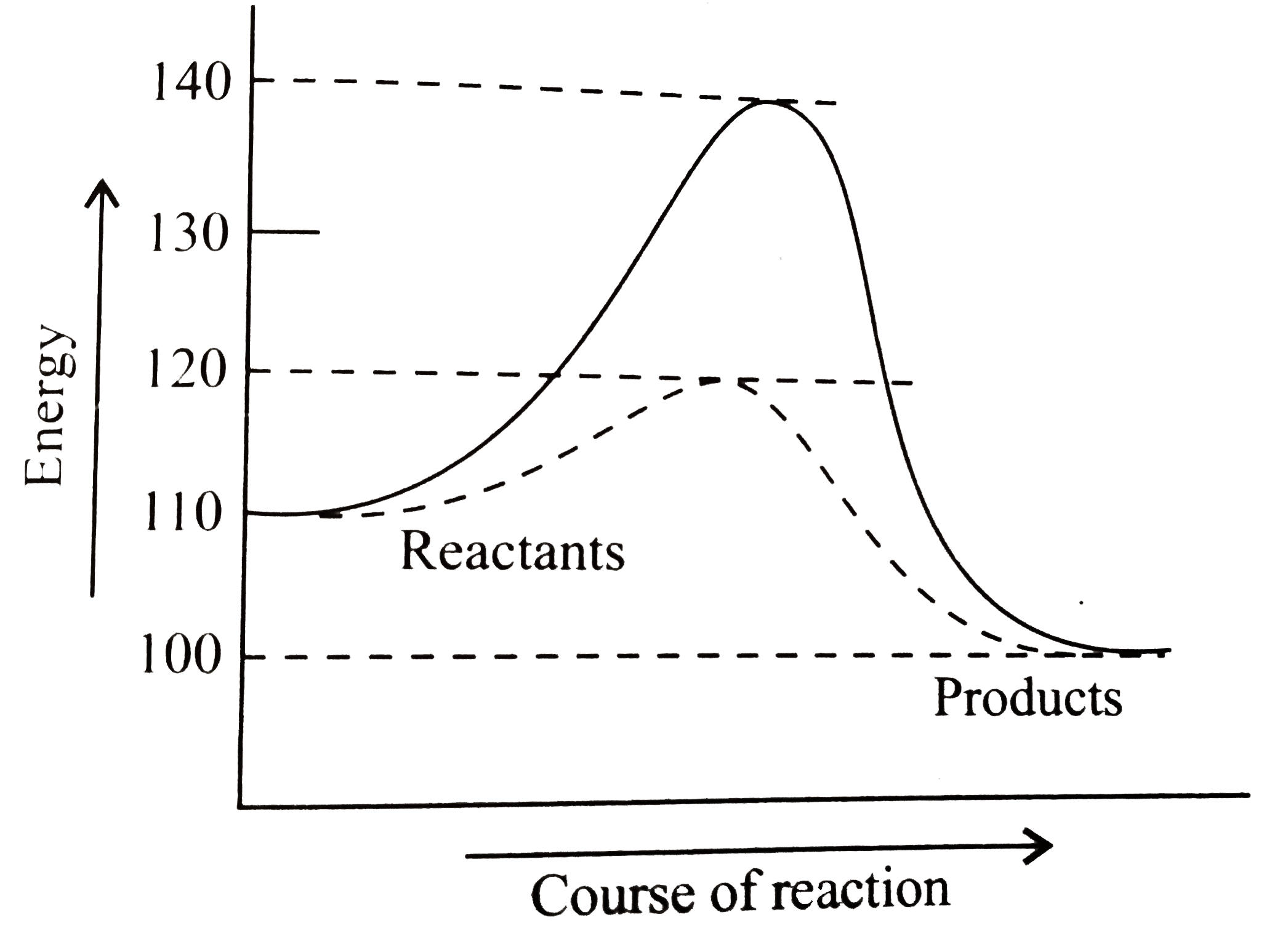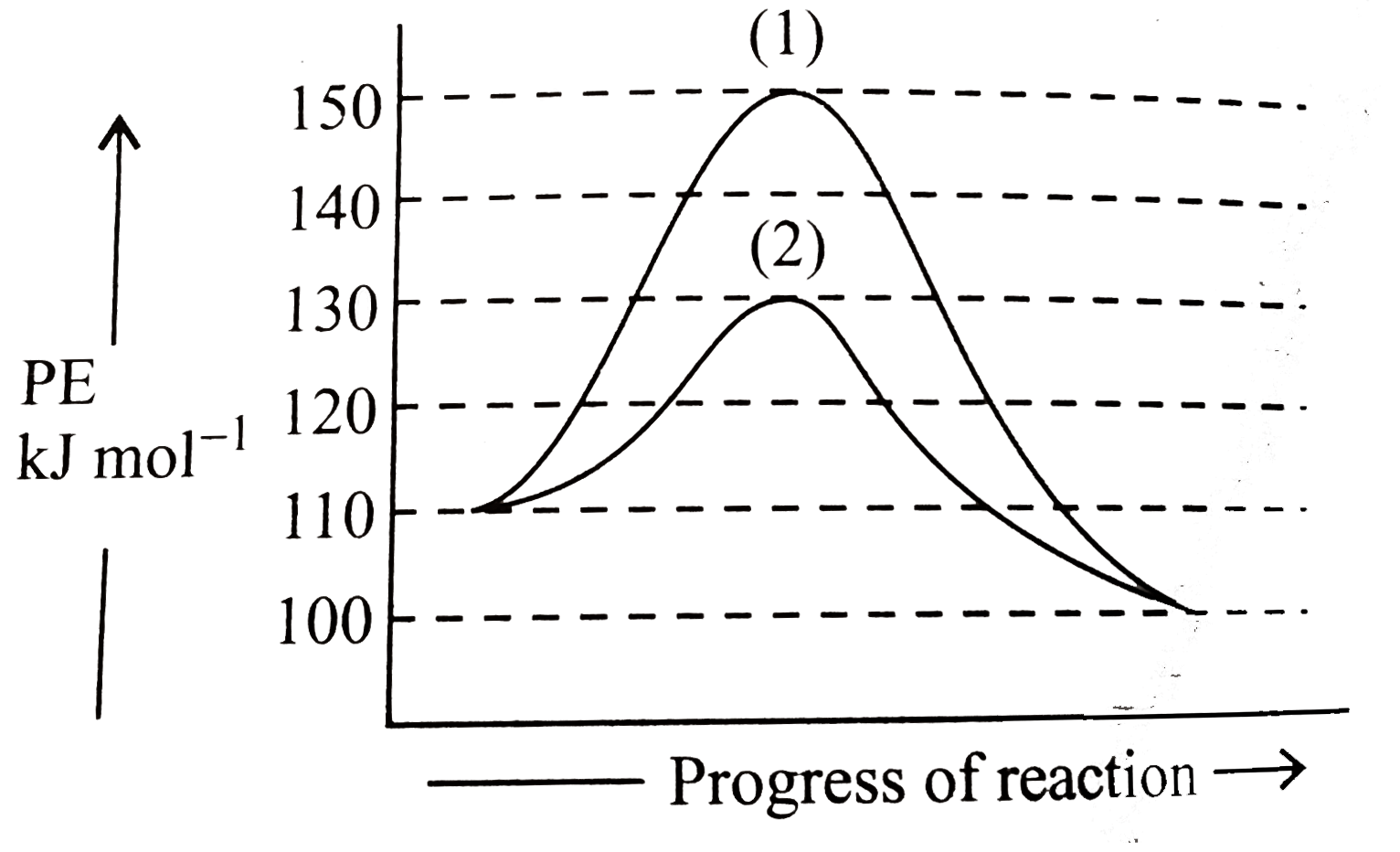From the given figure:
i) Calculate for the reaction and energy of activation for the forward reaction and energy of activation for the backward reaction.
ii) The dotted curve is in the presence of a catalyst, what is the energy of activation for the two reactions in the presence of the catalyst?
iii) will the catalyst change the extent of the reaction?

i)For the uncatalysed reaction, represented by upper curve
Energy of the reaction
Energy of the products
Change in the internal energy
Energy of activation for the reverse reaction
ii) For the catalyst reaction, represented by lower curve,
iii) There will no effect on the extent for the reaction because the activation energies for the forward reactions have decreased equally.

Topper's Solved these Questions
- CHEMICAL KINETICSBOOK - DINESH PUBLICATIONCHAPTER - CHEMICAL KINETICSEXERCISE - Multiple Choice Questions
32 Videos
- CHEMICAL KINETICSBOOK - DINESH PUBLICATIONCHAPTER - CHEMICAL KINETICSEXERCISE - Multiple type questions
4 Videos
- CHEMICAL KINETICSBOOK - DINESH PUBLICATIONCHAPTER - CHEMICAL KINETICSEXERCISE - Qestions from board examinations
97 Videos
- CHEMICAL BONDING AND MOLECULAR STRUCTUREBOOK - DINESH PUBLICATIONCHAPTER - CHEMICAL BONDING AND MOLECULAR STRUCTUREEXERCISE - Unit Test - 1
20 Videos
- CHEMICAL THERMODYNAMICS AND CHEMICAL ENERGETICS BOOK - DINESH PUBLICATIONCHAPTER - CHEMICAL THERMODYNAMICS AND CHEMICAL ENERGETICS EXERCISE - Exercise
507 Videos
Similar Questions
Refer picture given below.
(a) Calculate ΔH for the reaction and the energy of activation for the forward reaction as well as backward reaction.
(b) The dotted curve is in the presence of a catalyst. What is the energy of activation for the two reactions in the presence of catalyst?
( c) Will the catalyst change the extent of reaction?

View SolutionRefer picture given below.
(a) Calculate ΔH for the reaction and the energy of activation for the forward reaction as well as backward reaction.
(b) The dotted curve is in the presence of a catalyst. What is the energy of activation for the two reactions in the presence of catalyst?
( c) Will the catalyst change the extent of reaction?

View Solution
Knowledge Check
For a reversible reaction, A+B?C+D,ΔH=–A kcal. If energy of activation for the forward reaction is B kcal, the energy of activation for backward reaction in kcal is :
A−A+BBA+BCA−BD−A−BSTATEMENT-1 : A catalyst enhances the rate of a reaction
and
STATEMENT-2 : The energy of activation of the reaction is lowered in presence of a catalyst.ASTATEMENT-1 is True, STATEMENT-2 is True, STATEMENT-2 is correct explanation for STATEMENT-1BSTATEMENT-1 is True, STATEMENT-2 is True, STATEMENT-2 is NOT a correct explanation for STATEMENT-1CSTATEMENT-1 True, STATEMENT-2 is FalseDSTATEMENT-1 is False, STATEMENT-2 is TrueConsider the reaction
A→2B+C,ΔH=−15kcal. The energy of activation of backward reaction is 20kcalmol−1. In presence of catalyst, the energy of activation of forward reaction is 3kcalmol−1.At 400 K the catalyst causes the rate of the forward reaction to increase by the number of times equal to -Ae3.5Be2.5Ce−2.5De2.303
Given the following graph.
(a) Calculate ΔH for the reaction and energy of activation for the forward and backward reaction.

(b) Curve (2) is the energy profile in the presence of a catalyst. What is the energy of activation for the two reaction in the presence of a catalyst?
( c) Will the catalyst change the extent of the reaction?
View SolutionThe negative catalyst decreases the activation energy of a reaction.
View SolutionA poistive catalyst increases the activation energy of the reaction.
View SolutionA poistive catalyst increases the activation energy of the reaction.
View Solution(A) A catalyst increases the rate of areaction.
(R)In presence of a catalyst, the activation energy of the reaction increases.
View Solution
